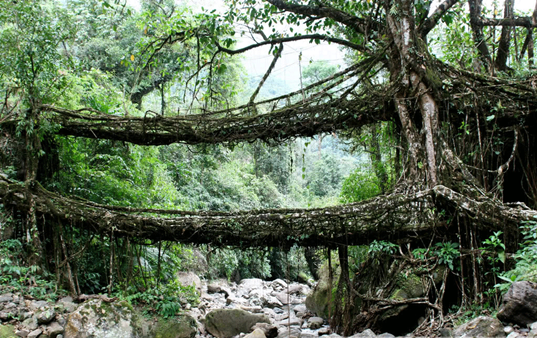 Introduction
Introduction
 Meghalaya emerged as a full-fledged state within the union of India on 21st Jan 1972. It is tucked in the North East of India, covering an area of 22489 sq. km. The State lies within 25°1'and 26°5'North latitudes and 85°49'and 92°52'East Longitudes.
Meghalaya emerged as a full-fledged state within the union of India on 21st Jan 1972. It is tucked in the North East of India, covering an area of 22489 sq. km. The State lies within 25°1'and 26°5'North latitudes and 85°49'and 92°52'East Longitudes.
The temperature range is approximately 2 degree centigrade to 36 degree centigrade depending upon the altitude ranging between 300 mts above mean sea level (MSL) to 2000 mts above MSL. Meghalaya is amongst the highest rainfall areas in the world with an annual average rainfall of 11,000 mm during the period of 1980-91, predominantly mountainous, lying between the Brahmaputra valley in the North and the Surma valley (Bangladesh) in the South.
The economy of Meghalaya is basically agrarian as it is rural based with Agriculture playing a predominant role in the state's economy. Since, 81% of the state's population depends on Agriculture, employment and income generation also depends on Agricultural developmental activities to a great extent. The State is yet to touch the National Level in economic and agricultural growth rate even after attaining full statehood more than twenty-five years ago. The State is slowly and steadily progressing inspite of the numerous constraints and limiting factors.
Practising of improved and modern methods of Agriculture by the farmers, using of Chemical fertilizers, Plant protection measures and introduction of High Yielding Variety (HYV) seeds of Paddy, Wheat, Maize etc has contributed to the increase in production of foodgrains. Mechanisation of Agriculture has gone up to some extent. Progressive farmers are able to produce more and in turn they supply seeds to the Department for distribution to small and marginal farmers.
Though, 81% of the population depends on agriculture, the net cropped area is only about 9.87% of the total geographical area of the State. The state is deficit in foodgrains by 1.22 lakh tonnes annually to feed a population of 2.3 million. This is due to a lot of constraints, such as the undulating topography, transport and communication problem, population dispersal pattern, inadequate credit support, poor marketing system, etc. To overcome these hurdles, future programmes are proposed, like increasing agricultural/horticultural production and productivity, research system on the development of economically viable and location specific technologies in rainfed, flood-prone irrigated areas, and increasing the utilisation of irrigation potential etc.





